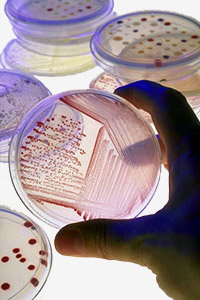 Airborne Microbial Contamination & Indoor Air Quality
Airborne Microbial Contamination & Indoor Air Quality
There are many factors that can contribute to microbial contamination. Several pathways can lead to the introduction of pathogenic organisms and areas of potential hazards must be identified and addressed. Simple precautionary measures can be taken to prevent points of concern from becoming contamination problems. Such precautionary measures such as Standard Operating Procedures (SOPs) are part of a comprehensive Hazard Analysis Critical Control Points (HACCP) plan.
Microbial contamination of the air is a concern because organisms can use air as a transport medium to either contaminate surfaces directly, or to contaminate contact surfaces. With air being considered a potential source of contamination, avenues which can allow the inside air to become contaminated must be controlled. Simple practices such as keeping doors closed or controlling traffic can be essential in controlling air contamination.
In conducting a hazard analysis, the tendency is to focus on sources of microbial contamination that are visible. Bacteria and molds, while not necessarily capable of becoming airborne, can attach to dirt and dust particles or moisture droplets and disperse throughout the air in an area. In fact, some have suggested that the use of high-pressure water may actually just move the contamination around. For instance, Listeria monocytogenes can survive for as long as 3.5 hours in an aerosol, like that created by washing with high-pressure water. Therefore it is important to consider all factors that may contribute to cross-contamination and consider air as a potential source of contamination.
Factors that may be pertinent may include, but are not limited to:
Open Doors: Doors should remain closed as much as possible. This will prevent entrance of excess outside air and fluctuation of ambient temperature and humidity. A major cause of open doors is increased employee traffic.
Employee Traffic: The area of highest traffic is the point at which the most people are moving in and out of the room during the day. People carry a number of microorganisms on their person. The movement of personnel is associated with higher contamination levels.
HVAC Fan Operation: HVAC fan operation causes increased air flow. Air flow will affect air contamination and, in the absence of walls, corners, or other means of separation, microorganisms may be moved by the air flow into clean areas. Usually, HVAC fan operation is triggered by a rise in temperature. The use of air filtration units installed into the HVAC system can reduce the amount of airborne bacteria.
Ambient Humidity In general, microbes usually grow best at temperatures above that typical of refrigeration (~45°F). Therefore maintaining cool temperatures is very important. Temperature within the facility can be maintained by the same means as humidity. Likewise, increase in ambient temperature also heightens the survival of microbes in the air.
These factors account for most of the variation in microbial contamination by means of airborne microbes. Therefore, if these factors are not controlled, they can lead to other factors affecting microbial survival in air. Such factors include: time of year, time of day, outside temperature, and outside humidity.
Processors can prevent the emergence of other factors which may or may not be controllable by controlling known factors. Practices as simple as closing doors and limiting employee traffic are effective means to ensure limited air contamination.
Control Measures
The simplest, most straight-forward method of controlling room air conditions is to make sure that all HVAC units are in good working order and consistently maintaining temperature. Additionally, doors should be kept closed at all times to reduce the chance of cross contamination and to assist the cooling units in maintaining temperature.
Research has shown that the installation of recirculating air filtration units are helpful in reducing the amount of bacteria and molds floating around in the air.
- While no regulations are in place requiring mold and spore decontamination, it is highly advisable to handle any unknown situation with caution to alleviate unnecessary danger. Certain molds and spores in high concentrations can cause adverse health effects if left untreated. Molds can multiply rapidly following exposure to water if not cleaned or dried quickly. "Sick Building Syndrome" is the condition of dangerous molds multiplying in an air ventilation system, causing sickness to the building tenants.
- Many molds are naturally occurring following a water damage event and most are relatively harmless, though the Stachybotre mold can be deadly when disturbed or improperly cleaned






